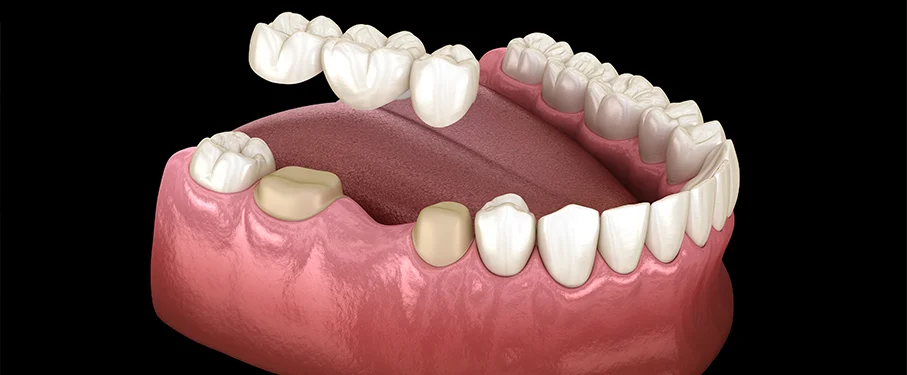- We Offer Instant Financing | Learn More
- Emergency Dental
- New Patients:
587-205-6093 - Current Patients:
403-527-9833 - Pay Now
Crowns and Bridges at Medicine Hat
What is the difference between a bridge and a crown? Crowns are a dental device that replaces the outer portion of your tooth when it is too damaged to support a filling. A bridge is a device that takes the place of missing adjacent teeth and is anchored on each side of the space. Your dentist will discuss your need for either of these dental devices and if you are a candidate for either of them. Note that crowns and bridges are permanently attached devices that are not removed once put in place.
Request an AppointmentCrowns
Your tooth has been filled and now the filling has come out leaving you with a ragged edge and discomfort. You may need to have a crown, also known as a cap, placed over that tooth now because it cannot support any further filling material. Once your tooth damage becomes extreme a crown will be used to cover and protect the portion of the tooth below the gums. Crowns look and act natural making them the ideal device to fix a rotted tooth. A crown can also be used to cover a tooth that has become discoloured over time. They can last for many years with the proper treatment and care.
What is a crown made of?
Metal
- Usually composed of gold
- Long lasting without breaking or chipping
- Can wear down opposing teeth
Composite
- Gives a natural appearance
- Wears down quicker than porcelain
- Can stain easily
Porcelain
- Looks like your natural teeth
- More susceptible to chipping
Porcelain Fused to Metal
- Strong
- Looks natural
- Not as likely to chip compared to porcelain or composite
- Metal might be visible near your gums
Getting a crown will take longer than getting your tooth filled. A temporary model will have to be made before the placement of the final product. An impression of your tooth will be made and sent to a lab where the crown will get custom made to fit your mouth. It generally takes two appointments to complete the crown and affix it to your tooth. Your Park Meadows dentist will explain the entire procedure to you before your treatment begins.

Bridges
You really can bridge the gap between your teeth with the help of a fixed bridge or commonly known as a bridge. If you have lost more than one tooth in a row you could be a good candidate for this type of dental procedure. A bridge is anchored to either your natural teeth or can be attached to dental implants. This permanent appliance is ideal to provide you with the aesthetics you desire as well as the full functionality of real teeth.
Ask your dentist about the different bridge options to give you back your full smile.
Bridges explained
Traditional
- You still have your natural teeth to support a bridge. A traditional bridge is supported one either side by attaching it to your existing teeth. These teeth must have strong roots, good bone support, and can be prepared by the placement of crowns.
Resin-Bonded or Maryland
- This type of bridge is used when 2 or more teeth are missing in the front of your mouth. An artificial row of teeth are created in a lab then when the bridge is ready it is attached to your natural teeth using metal bands. It can also be attached to implants depending on your situation.
Implant
- If you have no natural teeth to anchor the bridge your dentist may suggest implants. Implants are surgically placed artificial roots attached to your jaw bone with a lab-created tooth. Implants work well to support a bridge so long as your jaw has substantial bone to place the implant. Getting an implant requires time so you will likely be fitted with a temporary device until your jaw has healed from the procedure.
Custom Made
- Custom made bridges can be designed to your specifications with the guidance of your dentist.

What happens when you get a bridge? A bridge is made to fit the shape and size of your mouth. Your dentist will take a mould of your teeth and carefully measure your dental arch. The information will be sent to a lab where the construction of your new bridge will take place. Your dentist will place a temporary bridge in your mouth so you still have the functionality of your teeth. On the follow-up appointment, your permanent bridge will be placed in your mouth and secured with either metal bands or dental cement to give you a natural look and feel. Getting a bridge takes time but you will be pleased with the results of your new teeth.
Once your new bridge has been affixed inside your mouth you will care for it as you would your natural teeth. Regular brushing and cleaning will help keep your bridge looking good and prevent any issues. A bridge can loosen over time. Should this occur you will need to visit your dentist to determine the cause and to have it repaired. A bridge that has been in your mouth for several years may require replacement. Your dentist will monitor the integrity of the anchor teeth to ensure the bridge is functioning as it should. When the anchor teeth become weakened or abscessed, it may be time to consider implants or dentures. You can discuss these situations with your dentist at Park Meadows Dental during your regular appointments.


